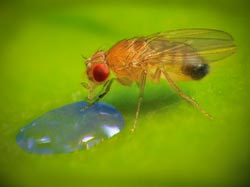How colors enter the world of the fly

To detect an object on the basis of color, flies use both inner and outer receptor cells of the innumerable ommatidia in the flies' compound eyes, as Bernstein scientists have now discovered.<br>Pavel Masek/Bernstein Koordinationsstelle, 2013<br>
To distinguish colors, the brain compares signals from sensory cells that are activated by light of different wavelengths. But how does color information reach a fly’s brain? Insects possess compound eyes, which are composed of many individual eye units, so-called ommatidia.
A single ommatidium consists of eight light-sensitive photoreceptor cells. Six of them are arranged in a ring, with the two remaining cells located in its center. In flies, the six outer receptor cells respond to light over a broad range of wavelengths. Since the perception of color depends on the processing of specific wavelength regions, researchers assumed that these receptors are mainly responsible for motion perception.
In contrast, the two inner photoreceptors are sensitive to light of single narrow wavelength regions—and may therefore pass on precise information about colors. So far, they have been considered to be the exclusive source of color vision in flies.
Neuroscientists at the Bernstein Center Munich, the Max Planck Institute of Neurobiology in Martinsried, and the LMU Munich now discovered that this assumption needs to be revised. “The outer photoreceptors contribute to color discrimination of the fly as well,” explains Thomas Wachtler, one of the researchers involved in the study. Using a computer model, the biologists mimicked the processing of photoreceptor signals in the fly eye—and realized that the wavelength sensitivity of the outer photoreceptors must be taken into account in order to obtain the fly's color discrimination abilities.
To support their theoretical results with experimental data, the researchers selectively controlled photoreceptor function in genetically manipulated flies. In this way, they obtained flies that possessed only one of the two color-specific inner receptor cells besides the outer receptor cells. Yet, the flies were able to distinguish two colors. “This indicates that the brain draws on information from both inner and outer photoreceptors for the color comparison,” explains Christopher Schnaitmann, first author of the study. The assumption was confirmed when the scientists inhibited the activity of nerve cells that convey signals from the outer receptor cells to the brain: the flies' ability to perceive color differences was severely impaired.
The outer photoreceptors thus seem to be true multitaskers, contributing to both motion and color vision in the fly. Their dual role makes sense in small animals: it ensures that despite a limited number of neurons, flies still have complex visual skills—and may easily distinguish a bread crumb from a dust grain.
The Bernstein Center Munich is part of the National Bernstein Network Computational Neuroscience in Germany. With this funding initiative, the German Federal Ministry of Education and Research (BMBF) has supported the new discipline of Computational Neuroscience since 2004 with over 170 million Euros. The network is named after the German physiologist Julius Bernstein (1835-1917).
Contact:
Dr. Hiromu Tanimoto
Max-Planck-Institut für Neurobiologie
Am Klopferspitz 18
82152 Martinsried
Tel: +49 (0)89 8578 3492
Email: hiromut@neuro.mpg.de
PD Dr. Thomas Wachtler
Ludwig-Maximilians-Universität
Department Biology II
Grosshadernerstr. 2
82152 Martinsried
Tel: +49 (0)89 2180 74810
Email: wachtler@bio.lmu.de
Original publication:
C. Schnaitmann, C. Garbers, T. Wachtler & H. Tanimoto (2013): Color discrimination with broadband photoreceptors. Current Biology, 23(23): 2375-82.
http://dx.doi.org/10.1016/j.cub.2013.10.037
Weitere Informationen:
http://www.neuro.mpg.de/tanimoto website Hiromu Tanimoto
http://neuro.bio.lmu.de/research_groups/res-wachtler_th website Thomas Wachtler
http://www.bccn-munich.de Bernstein Center Munich
http://www.uni-muenchen.de LMU Munich
http://wwww.nncn.de National Bernstein Network Computational Neuroscience
Media Contact
More Information:
http://wwww.nncn.deAll latest news from the category: Life Sciences and Chemistry
Articles and reports from the Life Sciences and chemistry area deal with applied and basic research into modern biology, chemistry and human medicine.
Valuable information can be found on a range of life sciences fields including bacteriology, biochemistry, bionics, bioinformatics, biophysics, biotechnology, genetics, geobotany, human biology, marine biology, microbiology, molecular biology, cellular biology, zoology, bioinorganic chemistry, microchemistry and environmental chemistry.
Newest articles

Skyrmions move at record speeds
… a step towards the computing of the future. An international research team led by scientists from the CNRS1 has discovered that the magnetic nanobubbles2 known as skyrmions can be…

A flexible and efficient DC power converter for sustainable-energy microgrids
A new DC-DC power converter is superior to previous designs and paves the way for more efficient, reliable and sustainable energy storage and conversion solutions. The Kobe University development can…

Technical Trials for Easing the (Cosmological) Tension
A new study sorts through models attempting to solve one of the major challenges of contemporary cosmic science, the measurement of its expansion. Thanks to the dizzying growth of cosmic…





















